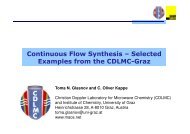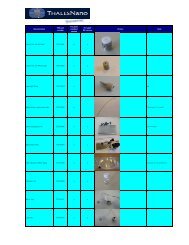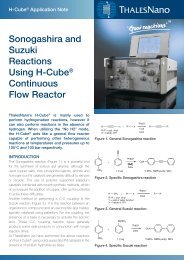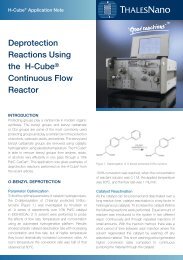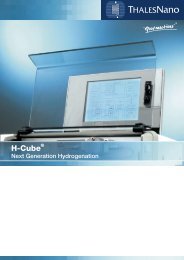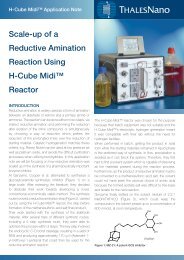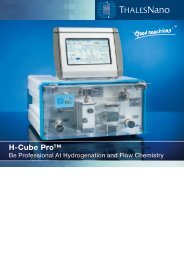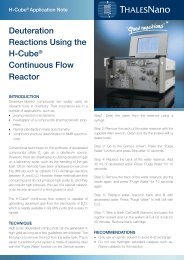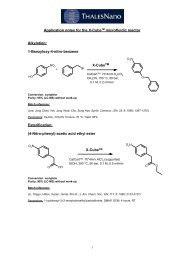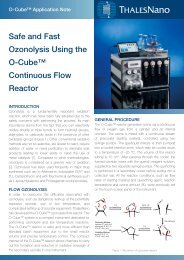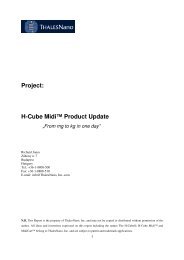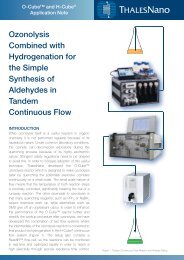Selective hydrogenation of cinnamaldehyde to ... - ThalesNano
Selective hydrogenation of cinnamaldehyde to ... - ThalesNano
Selective hydrogenation of cinnamaldehyde to ... - ThalesNano
You also want an ePaper? Increase the reach of your titles
YUMPU automatically turns print PDFs into web optimized ePapers that Google loves.
<strong>Selective</strong> <strong>hydrogenation</strong><br />
<strong>of</strong> <strong>cinnamaldehyde</strong> <strong>to</strong><br />
cinnamyl alcohol on a Pt<br />
nanoparticle based<br />
catalyst using the<br />
H-Cube ® Flow Reac<strong>to</strong>r<br />
INTRODUCTION<br />
<strong>Selective</strong> catalytic <strong>hydrogenation</strong> <strong>of</strong> a-b-unsaturated<br />
aldehydes is an important step in the industrial preparation<br />
<strong>of</strong> fine chemicals and attracts much interest for<br />
fundamental research in catalysis1. Cinnamyl alcohol<br />
plays an important role in the perfume and flavouring<br />
industries. The process can, however, lead <strong>to</strong> three<br />
different products: saturated aldehyde, saturated alcohol<br />
and the desired unsaturated alcohol (see Scheme 1.).<br />
The <strong>hydrogenation</strong> <strong>of</strong> the C=C bond in a-b-unsaturated<br />
aldehydes is both kinetically and thermodynamically<br />
more favorable than that <strong>of</strong> the C=O group 2 .<br />
Scheme 1. Reaction network <strong>of</strong> the<br />
<strong>hydrogenation</strong> <strong>of</strong> <strong>cinnamaldehyde</strong><br />
H-Cube ®<br />
Application<br />
Note<br />
The most significant fac<strong>to</strong>rs determining the selectivity<br />
are: the type and the structure <strong>of</strong> the active metal, the<br />
type <strong>of</strong> the substrate, and the conditions <strong>of</strong> the reaction,<br />
namely, the hydrogen pressure and the reaction<br />
temperature.<br />
The influence <strong>of</strong> the latter fac<strong>to</strong>rs can be easily investigated<br />
by using the H-Cube®, which is a standalone<br />
<strong>hydrogenation</strong> reac<strong>to</strong>r combining continuous-flow<br />
microchemistry with on-demand hydrogen generation<br />
and a disposable catalyst cartridge (CatCart®) system 3 .
H-Cube ® Application Note<br />
CATALYST<br />
Well-defined platinum nanoparticles with an average<br />
size <strong>of</strong> 2-3 nm were prepared by a continuous flow<br />
alcohol reduction process according <strong>to</strong> a recently<br />
described method4. The active metal building blocks<br />
were then anchored on<strong>to</strong> a high specific surface area<br />
silica support, and the catalyst was activated by<br />
temperature pre-treatment prior <strong>to</strong> use. The catalyst<br />
shows superior activity and selectivity in the <strong>hydrogenation</strong><br />
<strong>of</strong> <strong>cinnamaldehyde</strong> <strong>to</strong> conventional Pt/SiO2. STANDARD EXPERIMENTAL PROTOCOL<br />
After switching on the H-Cube ® and filling the water<br />
reservoir with de-ionized water, the desired CatCart ®<br />
is fixed in<strong>to</strong> its holder. After selecting the required flow<br />
rate, the reaction solvent is initially allowed <strong>to</strong> flow through<br />
the CatCart ® for 1 minute <strong>to</strong> remove the air from the<br />
system. The temperature and pressure <strong>of</strong> the system<br />
were set, the hydrogen production activated, and the<br />
mixture <strong>of</strong> solvent and hydrogen allowed <strong>to</strong> flow through<br />
the CatCart ®. A sample <strong>of</strong> the substrate was pumped<br />
through the H-Cube ® and the <strong>to</strong>tal amount <strong>of</strong> reaction<br />
mixture was collected in a sample vial. The column was<br />
then washed with the eluent <strong>to</strong> remove any material still<br />
absorbed on the CatCart ® . The product mixture was<br />
analyzed by GC-MS.<br />
EXPERIMENTAL PROCEDURE<br />
Using 1% Pt/Silica as catalyst, 200 mL Cinnamaldehyde<br />
(0.02 mol, 2.64 g) in ethanol was pumped through the<br />
H-Cube ® at a 1 mL/min flow rate. In order <strong>to</strong> avoid<br />
production <strong>of</strong> the undesired chelate between<br />
<strong>cinnamaldehyde</strong> and ethanol, freshly prepared reaction<br />
mixture has <strong>to</strong> be used! To find the optimal parameters<br />
<strong>of</strong> this selective <strong>hydrogenation</strong>, the effect <strong>of</strong> pressure<br />
and temperature on the the yield <strong>of</strong> the desired product,<br />
cinnamyl alcohol, were investigated. The applied<br />
pressures were 30, 60 and 90 bar, the applied<br />
temperatures were 20, 40, 60, 80 and 100°C,<br />
respectively.<br />
After the CatCart ® was washed with ethanol for 10<br />
minutes, the reaction mixture was allowed <strong>to</strong> flow through<br />
the reac<strong>to</strong>r. Product samples for GC-MS analysis were<br />
taken after 15 min. reaction time in each case. The<br />
CatCart ® was then washed with pure ethanol for 15<br />
min.<br />
RESULTS<br />
The results <strong>of</strong> the experiments investigating the effect<br />
<strong>of</strong> temperature and pressure on the formation <strong>of</strong> cinnamyl<br />
alcohol are given in Figure 1. below.<br />
Figure 1.<br />
Conversions as a function <strong>of</strong> reaction<br />
temperature and pressure<br />
It is clearly seen that increasing pressure and reaction<br />
temperature shifts the <strong>cinnamaldehyde</strong> transformation<br />
reaction <strong>to</strong> higher conversions. At high temperature and<br />
pressure conversions above 70% were detected.<br />
The selectivity <strong>of</strong> the desired cinnamyl alcohol as a<br />
function <strong>of</strong> the pressure and reaction temperature is<br />
shown in Figure 2.
Figure 2.<br />
Selectivity <strong>of</strong> produced cinnamyl alcohol as a<br />
function <strong>of</strong> temperature and pressure<br />
The figure shows that the effect <strong>of</strong> pressure on the<br />
selectivity <strong>of</strong> cinnamyl alcohol is hardly observed. On<br />
the other hand, increasing reaction temperature favours<br />
the formation <strong>of</strong> the desired unsaturated alcohol product.<br />
In reactions at high temperatures, selectivities between<br />
80 and 100% were observed. The formation <strong>of</strong> byproducts,<br />
benzene propanol and benzene propanal<br />
were also detected.<br />
11,3 s, 13%<br />
11.9 s, 80%<br />
H-Cube ® Application Note<br />
Figure 3.<br />
Yield <strong>of</strong> cinnamyl alcohol as a function <strong>of</strong><br />
temperature and pressure<br />
The dependence <strong>of</strong> product yield on the pressure and<br />
reaction temperature is shown in Figure 3.<br />
It is clearly seen that the increasing pressure gives higher<br />
yield values. The same effect can be obtained when<br />
reaction temperature is increased. At high pressures<br />
and temperatures yield values above 70% were<br />
determined.<br />
OPTIMAL REACTION CONDITIONS<br />
In order <strong>to</strong> increase the yield, flow rate was reduced<br />
stepwise by 0.1 mL/min at the optimal conditions <strong>of</strong><br />
T=80°C and p=60 bar. The highest cinnamyl alcohol<br />
yield was observed at v=0.25 mL/min. Analysis <strong>of</strong> the<br />
reaction mixtures using GC-MS under these optimal<br />
conditions is shown in Figure 4. The conversion was<br />
86.3%, the selectivity <strong>to</strong>wards cinnamyl alcohol was<br />
93% and the determined yield was 60.2%.<br />
Figure 4. GC-MS spectrum <strong>of</strong> <strong>cinnamaldehyde</strong> transformation in an H-Cube ® at T=80°C, p=60 bar, v=0.25 mL/min
LITERATURE COMPARISON<br />
The reduction <strong>of</strong> <strong>cinnamaldehyde</strong> on the H-Cube ®<br />
was compared with literature batch reactions. In the<br />
literature, 40-100% conversions and 50% selectivity <strong>of</strong><br />
the cinnamyl alcohol were observed5,6. It is widely accepted in the literature that high pressure<br />
is required for the selective <strong>hydrogenation</strong> <strong>of</strong> the C=O<br />
bond in a-b-unsaturated alcohols1,7. In au<strong>to</strong>clave<br />
reference experiments5,6 however, a maximum <strong>of</strong> 50<br />
bar pressure was applied. Therefore, the applied high<br />
pressure, and well-controlled liquid-gas ratio, ensured<br />
by H-Cube ®, is responsible for the high selectivity<br />
observed.<br />
However, the well-controlled, narrow particle size<br />
distribution <strong>of</strong> Pt on the catalyst surface can be the<br />
other reason for the high performance.<br />
REFERENCES<br />
CONCLUSION<br />
The results show that the selectivity <strong>of</strong> the H-Cube ® flow<br />
reac<strong>to</strong>r in the reduction <strong>of</strong> <strong>cinnamaldehyde</strong> is substantially<br />
higher when compared with the same reaction carried<br />
out in batch. The optimal reaction parameters were 80°C<br />
and 60 bar giving a conversion <strong>of</strong> 86.3%, a selectivity<br />
<strong>of</strong> 93% and a yield <strong>of</strong> 60.2%. The high performance <strong>of</strong><br />
the catalyst under flow conditions is determined by the<br />
well-defined nature <strong>of</strong> the nanoparticles developed.<br />
The catalyst is a product <strong>of</strong> ComErgen. CatCarts ® are<br />
available from <strong>ThalesNano</strong>.<br />
Please check at www.thalesnano.com.<br />
[1] Claus, P., Top. Cataly., 1998, 5, 51-62<br />
[2] Vannice, M.A., Sen, B., J. Catal, 1989, 115, 65-78<br />
[3] More details about H-Cube ® technology at www.thalesnano.com<br />
[4] Niesz, K., Hornyák, I., Borcsek, B., Darvas, F., Micr<strong>of</strong>luid. Nan<strong>of</strong>luid., 2008, in press,<br />
doi: 10.1007/s10404-008-0257-9<br />
[5] Samant, P. V., Pereira, M. F. R., Figueiredo, J. L. Catal. Today 2005, 102-103, 183-188.<br />
[6] Hájek, J. Kumar, N. Nieminen, V. Mäki-Arvela, P. Salmi, T. Yu. D. Murzin, Cerveny, L. Chem.<br />
Eng. J. 2004, 103, 35-43.<br />
[7] Bron, M., Teschner, D., Knop-Gericke, A., Steinhauer, B., Scheybal, A., Hävecker, M., Wang,<br />
D., Födisch, R., Hönicke, D., Wootsch, A., Schlögl, R., Claus, P., J. Catal. 2005, 234, 37-47.<br />
For further information please contact us at flowchemistry@thalesnano.com or visit our website:<br />
www. thalesnano.com<br />
<strong>ThalesNano</strong> Nanotechnology Inc.<br />
Zahony u. 7.<br />
H-1031 Budapest<br />
Hungary<br />
Tel.: +36 1 880 8500<br />
Fax.: +36 1 880 8501<br />
US Office<br />
Prince<strong>to</strong>n<br />
7 Deer Park Drive, Suite M-3<br />
Monmouth JCT NJ 08852<br />
US<br />
Tel.: +1 732 274 3388<br />
UK Office<br />
Carl Jones<br />
Head <strong>of</strong> Sales<br />
Tel.: +44 (0) 7868 843 819



